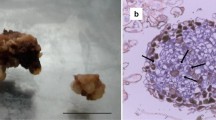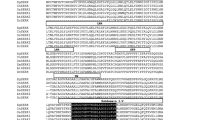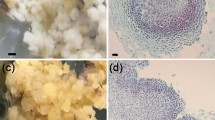Abstract
Somatic embryogenesis involves different molecular events including differential gene expression and various signal transduction pathways. One of the genes identified in early somatic embryogenesis is S OMATIC E MBRYOGENESIS R ECEPTOR-like K INASE (SERK). Cocos nucifera (L.) is one of the most recalcitrant species for in vitro regeneration, achieved so far only through somatic embryogenesis, although just a few embryos could be obtained from a single explant. In order to increase efficiency of this process we need to understand it better. Therefore, the purpose of the present work was to determine if an ortholog of the SERK gene is present in the coconut genome, isolate it and analyze its expression during somatic embryogenesis. The results showed the occurrence of a SERK ortholog referred to as CnSERK. Predicted sequence analysis showed that CnSERK encodes a SERK protein with the domains reported in the SERK proteins in other species. These domains consist of a signal peptide, a leucine zipper domain, five LRR, the Serine-Proline-Proline domain, which is a distinctive domain of the SERK proteins, a single transmembrane domain, the kinase domain with 11 subdomains and the C terminal region. Analysis of its expression showed that it could be detected in embryogenic tissues before embryo development could be observed. In contrast it was not detected or at lower levels in non-embryogenic tissues, thus suggesting that CnSERK expression is associated with induction of somatic embryogenesis and that it could be a potential marker of cells competent to form somatic embryos in coconut tissues cultured in vitro.






Similar content being viewed by others
References
Baudino S, Hansen S, Brettshneider R, Hecht VFG, Dresselhaus T, Lors H, Dumas C, Rogowsky PM (2001) Molecular characterization of two novel maiz LRR receptor-like kinase, which belong to the SERK gene family. Planta 213:1–10
Buffard-Morel J, Verdeil JL, Pannetier C (1992) Embryogenêse somatique du cocotier (Cocos nucifera L.) á partir d′explants foliares: étude histologique. Can J Bot 70:735–741
Chugh A, Khurana P (2002) Gene expression during somatic embryogenesis-recent advances. Curr Sci 83(6):715–730
de Oliveira SM, Romano E, Clemente KS, Penha ML, Andrade B, Lima FJ (2005) Characterisation of the cacao somatic embryogenesis receptor-like kinase (SERK) gene expressed during somatic embryogenesis. Plant Sci 168(3):723–729
Eeuwens CJ (1976) Mineral requirements for growth and callus initiation of tissue explants excised from mature coconut palms (Cocos nucifera) and date (Phoenix dactylifera) palms cultured in vitro. Physiol Plant 42:173–178
Fisher DB (1968) Protein staining of ribboned epon sections for ligth microscopy. Histochemie 16:92–96
Hecht V, Vielle-Calzada JP, Hartog MV, Schmidt ED, Boutilier K, Grossniklaus U, de Vries SC (2001) The Arabidopsis SOMATIC EMBRYOGENESIS RECEPTOR KINASE 1 gene is expressed in developing ovules and embryos and enhances embryogenic competence in culture. Plant Physiol 127:803–816
Hu H, Xiong L, Yang Y (2005) Rice SERK1 gene positively regulates somatic embryogenesis of cultured cell and host defense response against fungal infection. Planta 222(1):107–117
Islas-Flores I, Chan JL, Oropeza C, Hernández-Sotomayor SMT (2000) Occurrence of phosphorylated proteins and kinase activity in coconut tissues cultured in vitro in a medium that induces somatic embryogenesis. Plant Physiol Biochem 38:825–836
Koltai H, Bird DM (2000) High throughput cellular localization of specific plant mRNAs by liquid-phase in situ reverse transcription-polymerase chain reaction of tissue sections. Plant Physiol 123:1203–1212
Kwaaitaal MSCJ, de Vries SC (2007) The SERK1 gene is expressed in procambium and immature vascular cells. J Exp Bot 58(11):2887–2896
Livak KJ, Schmittgen TD (2001) Analysis of relative gene expression data using real-time quantitative PCR and the 2(-Delta Delta C(T)) method. Methods 25(4):402–408
Nolan KE, Irwanto RR, Rose RJ (2003) Auxin up-regulates MtSERK 1 expression in both Medicago truncatula root forming and embryogenic cultures. Plant Physiol 133:218–230
Oropeza C, Rillo E, Hocher V, Verdeil JL (2005) Coconut micropropagation. In: Batugal P, Rao VR, Oliver J (eds) Coconut genetic resources. IPGRI-APO, Serdang, pp 334–346
Pérez-Núñez MT, Chan JL, Sáenz L, González T, Verdeil JL, Oropeza C (2006) Improved somatic embryogenesis from Cocos nucifera (L.) plumule explants. In vitro Cell Dev Biol Plant 42:37–43
Sáenz L, Souza R, Chan JL, Azpeitia A, Oropeza C (2005) 14C-2, 4-dichlorophenoxyacetic acid uptake and formation of embryogenic calli in coconut plumular explants cultured on activated charcoal-free media. Rev Fitotecnia Mex 28(2):151–159
Schmidt EDL, Guzzo F, Toonen MAJ, de Vries SC (1997) A leucine rich repeat containing receptor-like kinase marks somatic plant cells competent to form embryos. Development 124:2049–2062
Shah K, Vervoort J, de Vries S (2001) Role of threonines in the Arabidopsis thaliana somatic embryogenesis receptor kinase 1 activation loop in phosphorylation. J Biol Chem 276(44):41263–41269
Somleva MN, Schmidt EDL, de Vries SC (2000) Embryogenic cells in Dactylis glomerata L. (Poaceae) explants identified by cell tracking and by SERK expression. Plant Cell Rep 19:718–726
Thomas C, Meyer D, Himber C, Steinmetz A (2004) Spatial expression of a sunflower SERK gene during induction of somatic embryogenesis and shoot organogenesis. Plant Physiol Biochem 42:35–42
Verdeil JL, Alemanno L, Niemenak N, Tranbarger TJ (2007) Pluripotent versus totipotent plant stem cells: dependence versus autonomy? Trends Plant Sci 12(6):245–252
Acknowledgments
The authors would like to thank CONACYT (México) for partial funding for the research reported here (Grant 43834-Z) and for a scholarship for M.T. Pérez-Núñez (Grant 162930).
Author information
Authors and Affiliations
Corresponding author
Additional information
Communicated by P. Ozias-Akins.
Rights and permissions
About this article
Cite this article
Pérez-Núñez, M.T., Souza, R., Sáenz, L. et al. Detection of a SERK-like gene in coconut and analysis of its expression during the formation of embryogenic callus and somatic embryos. Plant Cell Rep 28, 11–19 (2009). https://doi.org/10.1007/s00299-008-0616-8
Received:
Revised:
Accepted:
Published:
Issue Date:
DOI: https://doi.org/10.1007/s00299-008-0616-8




